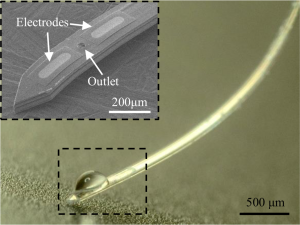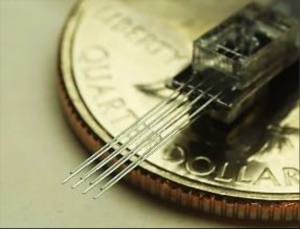

Reference
[Paper Full Text (Valid till April 16, 2019)]
Neural probes have been developed to help us understand how brain functions. With the advancement of MEMS and IC technology, silicon probes with high density electrodes has been developed. Those hard probes can be easily insert into the brain while providing stable extracellular neural activity measurements. However, the neuroimmune response caused by the intrinsic mechanical mismatch between the silicon probe and the brain tissue has limited their usage for advanced electrophysiology studies.
Recently, plastic (e.g., polyimide, SU-8) probes has recently been proposed and developed to minimize the impact of those probes in brain, especially for long-term studies. However, still made from materials that is ~5 orders of magnitude hard than the brain tissue, existing flexible plastic probes cannot eliminate all mechanical mismatch and would still cause wounds/scar from micromotions of the brain tissues. Furthermore, flexible probes often require another hard shuttle devices (e.g., glass/carbon fibers or metal wires) during their insertion into the brain, resulting in inevitable damage to brain tissues that are prone to neuroimmune response.
Here we present our elegant solution to address the two above-mentioned problems with a stiffness-tunable neural probe that is hard like silicon/metal needles during insertion while soft like brain tissue when in service. This ultra-flexible and ultra-stretchable neural probe is made of elastomer that is slightly harder than the brain tissue and liquid metal gallium that provides both electrical connection and tunable mechanical stiffness. It features:
- 5 orders of magnitude tunable stiffness
- 2-cm long probe for deep-brain studies
- microfluidic channels for chemical agent delivery
- high-performance electrochemical glutamate sensing
[youtube=https://youtu.be/qcVJ5s5Nsoo&w=320&h=180]
Our ULTS (right) shows essentially no in-brain movement while the “flexible” silicon (left) and plastic (middle) probes scratch both laterally and vertically with the micromotion between the probe and the brain.